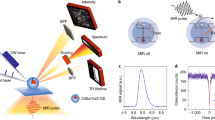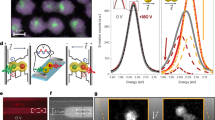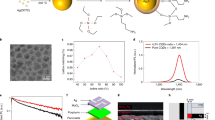Abstract
Colloidal semiconductor quantum dots are fluorescent nanocrystals exhibiting exceptional optical properties, but their emission intensity strongly depends on their charging state and local environment. This leads to blinking at the single-particle level or even complete fluorescence quenching, and limits the applications of quantum dots as fluorescent particles. Here, we show that a single quantum dot encapsulated in a silica shell coated with a continuous gold nanoshell provides a system with a stable and Poissonian emission at room temperature that is preserved regardless of drastic changes in the local environment. This novel hybrid quantum dot/silica/gold structure behaves as a plasmonic resonator with a strong Purcell factor, in very good agreement with simulations. The gold nanoshell also acts as a shield that protects the quantum dot fluorescence and enhances its resistance to high-power photoexcitation or high-energy electron beams. This plasmonic fluorescent resonator opens the way to a new family of plasmonic nanoemitters with robust optical properties.
This is a preview of subscription content, access via your institution
Access options
Subscribe to this journal
Receive 12 print issues and online access
$259.00 per year
only $21.58 per issue
Buy this article
- Purchase on Springer Link
- Instant access to full article PDF
Prices may be subject to local taxes which are calculated during checkout




Similar content being viewed by others
References
Resch-Genger, U., Grabolle, M., Cavaliere-Jaricot, S., Nitschke, R. & Nann, T. Quantum dots versus organic dyes as fluorescent labels. Nature Methods 5, 763–775 (2008).
van Sark, W. G. J. H. M. et al. Photooxidation and photobleaching of single CdSe/ZnS quantum dots probed by room-temperature time-resolved spectroscopy. J. Phys. Chem. B 105, 8281–8284 (2001).
Nirmal, M. et al. Fluorescence intermittency in single cadmium selenide nanocrystals. Nature 383, 802–804 (1996).
Kuno, M., Fromm, D. P., Hamann, H. F., Gallagher, A. & Nesbitt, D. J. Nonexponential ‘blinking’ kinetics of single CdSe quantum dots: a universal power law behavior. J. Chem. Phys. 112, 3117–3120 (2000).
Lim, S. J., Kim, W., Jung, S., Seo, J. & Shin, S. K. Anisotropic etching of semiconductor nanocrystals. Chem. Mater. 23, 5029–5036 (2011).
Kalyuzhny, G. & Murray, R. W. Ligand effects on optical properties of CdSe nanocrystals. J. Phys. Chem. B 109, 7012–7021 (2005).
Son, D. H., Hughes, S. M., Yin, Y. & Alivisatos, P. A. Cation exchange reactions in ionic nanocrystals. Science 306, 1009–1012 (2004).
Cragg, G. E. & Efros, A. L. Suppression of Auger processes in confined structures. Nano Lett. 10, 313–317 (2009).
Spinicelli, P. et al. Bright and grey states in CdSe–CdS nanocrystals exhibiting strongly reduced blinking. Phys. Rev. Lett. 102, 136801 (2009).
Mahler, B. et al. Towards non-blinking colloidal quantum dots. Nature Mater. 7, 659–664 (2008).
Javaux, C. et al. Thermal activation of non-radiative Auger recombination in charged colloidal nanocrystals. Nature Nanotech. 8, 206–212 (2013).
Graf, C. & van Blaaderen, A. Metallodielectric colloidal core–shell particles for photonic applications. Langmuir 18, 524–534 (2001).
Brinson, B. E. et al. Nanoshells made easy: improving Au layer growth on nanoparticle surfaces. Langmuir 24, 14166–14171 (2008).
Canneson, D. et al. Strong Purcell effect observed in single thick-shell CdSe/CdS nanocrystals coupled to localized surface plasmons. Phys. Rev. B 84, 245423 (2011).
Drexhage, K. H., Kuhn, H. & Schäfer, F. P. Variation of the fluorescence decay time of a molecule in front of a mirror. Ber. Bunsenges. Phys. Chem. 72, 329 (1968).
Chance, R. R., Prock, A. & Silbey, R. Lifetime of an emitting molecule near a partially reflecting surface. J. Chem. Phys. 60, 2744–2748 (1974).
Gersten, J. & Nitzan, A. Spectroscopic properties of molecules interacting with small dielectric particles. J. Chem. Phys. 75, 1139–1152 (1981).
Kinkhabwala, A. et al. Large single-molecule fluorescence enhancements produced by a bowtie nanoantenna. Nature Photon. 3, 654–657 (2009).
Munechika, K. et al. Spectral control of plasmonic emission enhancement from quantum dots near single silver nanoprisms. Nano Lett. 10, 2598–2603 (2010).
Anger, P., Bharadwaj, P. & Novotny, L. Enhancement and quenching of single-molecule fluorescence. Phys. Rev. Lett. 96, 113002 (2006).
Kühn, S., Håkanson, U., Rogobete, L. & Sandoghdar, V. Enhancement of single-molecule fluorescence using a gold nanoparticle as an optical nanoantenna. Phys. Rev. Lett. 97, 017402 (2006).
Belacel, C. et al. Controlling spontaneous emission with plasmonic optical patch antennas. Nano Lett. 13, 1516–1521 (2013).
Dubertret, B., Calame, M. & Libchaber, A. J. Single-mismatch detection using gold-quenched fluorescent oligonucleotides. Nature Biotechnol. 19, 365–370 (2001).
Wylie, J. M. & Sipe, J. E. Quantum electrodynamics near an interface. Phys. Rev. A 30, 1185–1193 (1984).
Shimizu, K. T., Woo, W. K., Fisher, B. R., Eisler, H. J. & Bawendi, M. G. Surface-enhanced emission from single semiconductor nanocrystals. Phys. Rev. Lett. 89, 117401 (2002).
Ito, Y., Matsuda, K. & Kanemitsu, Y. Mechanism of photoluminescence enhancement in single semiconductor nanocrystals on metal surfaces. Phys. Rev. B 75, 033309 (2007).
LeBlanc, S. J., McClanahan, M. R., Jones, M. & Moyer, P. J. Enhancement of multiphoton emission from single CdSe quantum dots coupled to gold films. Nano Lett. 13, 1662–1669 (2013).
Song, J.-H., Atay, T., Shi, S., Urabe, H. & Nurmikko, A. V. Large enhancement of fluorescence efficiency from CdSe/ZnS quantum dots induced by resonant coupling to spatially controlled surface plasmons. Nano Lett. 5, 1557–1561 (2005).
Pompa, P. P. et al. Metal-enhanced fluorescence of colloidal nanocrystals with nanoscale control. Nature Nanotech. 1, 126–130 (2006).
Chan, Y.-H. et al. Using patterned arrays of metal nanoparticles to probe plasmon enhanced luminescence of CdSe quantum dots. ACS Nano 3, 1735–1744 (2009).
Liu, N., Prall, B. S. & Klimov, V. I. Hybrid gold/silica/nanocrystal–quantum-dot superstructures: synthesis and analysis of semiconductor–metal interactions. J. Am. Chem. Soc. 128, 15362–15363 (2006).
Ma, X., Tan, H., Kipp, T. & Mews, A. Fluorescence enhancement, blinking suppression, and gray states of individual semiconductor nanocrystals close to gold nanoparticles. Nano Lett. 10, 4166–4174 (2010).
Ratchford, D., Shafiei, F., Kim, S., Gray, S. K. & Li, X. Manipulating coupling between a single semiconductor quantum dot and single gold nanoparticle. Nano Lett. 11, 1049–1054 (2011).
Jin, Y. & Gao, X. Plasmonic fluorescent quantum dots. Nature Nanotech. 4, 571–576 (2009).
Enderlein, J. Theoretical study of single molecule fluorescence in a metallic nanocavity. Appl. Phys. Lett. 80, 315–317 (2002).
Prodan, E., Radloff, C., Halas, N. J. & Nordlander, P. A hybridization model for the plasmon response of complex nanostructures. Science 302, 419–422 (2003).
Miao, X. Y., Brener, I. & Luk, T. S. Nanocomposite plasmonic fluorescence emitters with core/shell configurations. J. Opt. Soc. Am. B 27, 1561–1570 (2010).
Mokari, T., Sztrum, C. G., Salant, A., Rabani, E. & Banin, U. Formation of asymmetric one-sided metal-tipped semiconductor nanocrystal dots and rods. Nature Mater. 4, 855–863 (2005).
Darbandi, M., Thomann, R. & Nann, T. Single quantum dots in silica spheres by microemulsion synthesis. Chem. Mater. 17, 5720–5725 (2005).
Koole, R. et al. On the incorporation mechanism of hydrophobic quantum dots in silica spheres by a reverse microemulsion method. Chem. Mater. 20, 2503–2512 (2008).
Chen, Y. et al. ‘Giant’ multishell CdSe nanocrystal quantum dots with suppressed blinking. J. Am. Chem. Soc. 130, 5026–5027 (2008).
Arroyo-Camejo, S. et al. Stimulated emission depletion microscopy resolves individual nitrogen vacancy centers in diamond nanocrystals. ACS Nano 7, 10912–10919 (2013).
Wang, F., Deng, R. & Liu, X. Preparation of core–shell NaGdF4 nanoparticles doped with luminescent lanthanide ions to be used as upconversion-based probes. Nature Protoc. 9, 1634–1644 (2014).
Acknowledgements
This work was supported by the Agence Nationale de la Recherche (ANR) through projects QDOTICS, and the Région Ile-de-France through the C'nano project ‘NanoAnt’. This work has also been supported by the Région Ile-de-France through the DIM Nano-K.
Author information
Authors and Affiliations
Contributions
J.J.G. and F.M. suggested the use of a gold nanoshell and supervised the theoretical analysis conducted by B.H. B.J. performed the synthesis of the golden quantum dots. E.G., N.L. and B.D. co-supervised B.J. P.S. carried out the spectroscopic experiments. X.Z. obtained the TEM images. E.G., B.D. and B.H. wrote the manuscript with help from the other authors. M.N. synthesized the thick-shell quantum dots. J.P.H. developed the numerical codes for the electromagnetic simulations.
Corresponding authors
Ethics declarations
Competing interests
The authors declare no competing financial interests.
Supplementary information
Supplementary information
Supplementary Information (PDF 973 kb)
Rights and permissions
About this article
Cite this article
Ji, B., Giovanelli, E., Habert, B. et al. Non-blinking quantum dot with a plasmonic nanoshell resonator. Nature Nanotech 10, 170–175 (2015). https://doi.org/10.1038/nnano.2014.298
Received:
Accepted:
Published:
Issue Date:
DOI: https://doi.org/10.1038/nnano.2014.298
This article is cited by
-
Ultrafast photoluminescence and multiscale light amplification in nanoplasmonic cavity glass
Nature Communications (2024)
-
Dynamical control of nanoscale light-matter interactions in low-dimensional quantum materials
Light: Science & Applications (2024)
-
Super-resolution microscopy enabled by high-efficiency surface-migration emission depletion
Nature Communications (2022)
-
All-optical fluorescence blinking control in quantum dots with ultrafast mid-infrared pulses
Nature Nanotechnology (2021)
-
Extreme multiexciton emission from deterministically assembled single-emitter subwavelength plasmonic patch antennas
Light: Science & Applications (2020)



